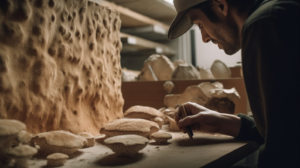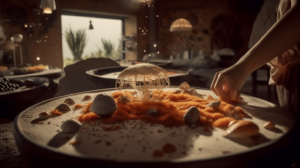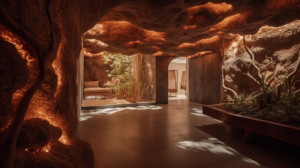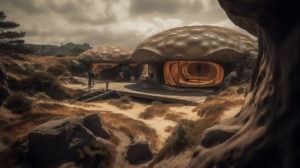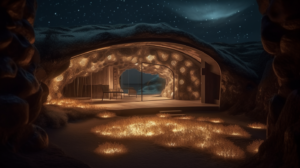Case Study
Regenerative Futures awards by SPACE10
¡Visita su web!Case Study
Research: Mycelium Village Community – Building a Sustainable Regenerative Future with AI
The Mycelium Village Community project is a unique endeavour that combines the power of AI, sustainable design, and community engagement to create a regenerative and innovative living concept. This case study explores the research, ideation, and implementation phases of the project, highlighting the team’s commitment to sustainability and their vision of inspiring the AI creators community and emerging entrepreneurs to prioritize sustainability.
- Project Objectives: The primary objective of the Mycelium Village Community project is to build a sustainable community that challenges existing beauty stigmas and promotes regenerative design. By showcasing the potential of mycelium-based structures, creating innovative community spaces and rethinking the food cycle, the project aims to inspire creativity, innovation, and sustainability within the AI community and beyond.
- Research and Ideation: The project commenced with thorough research, utilizing AI chat capabilities and Midjourney, to explore regenerative future opportunities. The themes were dived into various concepts and different scopes and topics were visualized. Ultimately, we opted for a community-focused approach and mycelium building as the most original and exciting idea. The research phase also involved considerations of ethical practices, respecting copyrights, and avoiding reference usage to maintain authenticity and creativity.
- Methodology and Visualization: The team leveraged AI chat capabilities to gather valuable insights and ideas. Midjourney, an innovative visualization tool, enabled the team to explore and experiment with different concepts, scopes, and design possibilities. The focus was on showcasing the dynamic life cycles, rather than static still images, to reflect real-world scenarios. The aim was to utilize AI as a sustainable tool, optimizing resource usage and avoiding unnecessary post-processing.
- Collaboration and Engagement: The project forms part of casafelisa lab researches and fosters collaboration and engagement with architects, health professionals, sustainability experts and other disciplines. This collaborative approach ensured that the Mycelium Village Community aligned with sustainable practices and addressed the unique needs of the community.
- Impact and Future Prospects: The Mycelium Village Community project aims to create a lasting impact by inspiring the AI creators community and emerging entrepreneurs to prioritize sustainability in their work. The innovative use of mycelium-based structures and AI-generated designs serves as a model for future sustainable development. The project’s scalability and potential for implementation in real-world scenarios make it a catalyst for positive change in building practices.
- Lessons Learned and Reflection: Throughout the project, we gained valuable insights and harnessed the potential of a powerful AI tool, further emphasizing the importance of collaboration, community engagement, and the synergy between our collective knowledge and emerging technologies like AI. This experience reinforced our commitment to promoting sustainability and fostering innovation in design, as we continue to work towards a resilient future.
Conclusion: The Mycelium Village Community project exemplifies the power of combining AI, sustainability, and community engagement. By showcasing the potential of mycelium-based structures and incorporating AI-generated designs, the project calls upon the AI creators community and emerging entrepreneurs to build with sustainability at heart. The case study highlights the research, ideation, methodology, collaboration, and impact of the project, inspiring a new generation of creators to prioritize sustainability and drive positive change in the built environment.
The process of creating mycelium material
The food cycle
Shared kitchen-lab and communal spaces
Educational spaces to promote mycelium culture
Exterior Exploration
Prompts suggested by GPT chat:
- Clustered mycelium houses with overlapping organic shapes
- Elevated view of the semi-subterranean architecture with desert vegetation and the coastal Spain in the background.
- Bioluminescent mycelium structures that provide lighting
- Minimal and elegant multifunctional meditation space with smooth and textured materials.
- Communal kitchen with sustainable wood and recycled materials, surrounded by a community garden with sustainable food sources.
- Wide-angle panoramic view of the eco-village with a warm and inviting color palette
- Biophilic design principles incorporated into the organic architecture.
- Abstract close-up of the intricate mycelium structures with bioluminescent properties.
- Sustainable food sources such as algae, fungi, and solar protein presented in a beautiful and attractive aesthetic.
- Twilight shot of the eco-village with the bioluminescent mycelium structures providing a serene and calming atmosphere.
- A close-up of the mycelium structure, showcasing its intricate and organic patterns
- A panoramic view of the surrounding landscape, with solar panels and wind turbines visible in the distance
- An interior shot of the communal kitchen, featuring state-of-the-art vertical hydroponic gardens and a smart composting system
- A night-time shot of the exterior, with bioluminescent mycelium accents highlighting the beauty of the organic material
- A bird’s-eye view of the eco-village, showcasing the interconnectedness of the mycelium homes and the sustainable transportation systems in place (e.g., electric bikes and community electric cars)
- An aerial shot of the surrounding agricultural land, featuring regenerative farming techniques such as crop rotation and companion planting
- An interior shot of the multifunctional meditation space, featuring smart lighting and air filtration systems for optimal health and well-being
- A close-up of the innovative water management system, featuring rainwater collection, greywater filtration, and a closed-loop aquaponics system
- An exterior shot of the mycelium home, showcasing the use of recycled and repurposed materials in its construction
- A time-lapse of the mycelium growing process, highlighting the regenerative and sustainable nature of the building material.
One of the final prompts for Midjourney:
organic mycelium semi-subterraneal eco-village with living walls, biophilic design elements, elevated view, Biomimicry, natural forms, community hub, Earthy or neutral tones, with pops of bright, natural colours, Bioluminescent mycelium roof glow, Coastal desert location, late sunset, misty, Serene mood, high quality photo –ar 16:9 –no stairs
Project full description
The mycelium eco-village is build of locally-sourced natural materials. Mycelium-based materials are also highly versatile and can be used for a range of construction purposes, including insulation, structural supports, and decorative finishes. They have excellent thermal and sound insulation properties, making them ideal for use in eco-friendly and energy-efficient buildings. Mycelium also has a variety of unique properties that can be incorporated into a sustainable and regenerative building project: 1. Bioluminescence: Mycelium can be genetically modified to produce bioluminescent properties, which can provide natural and energy-efficient lighting for the building. Self-healing: Mycelium has the ability to self-heal, which can reduce the need for repairs and maintenance in the building. Air filtration: Mycelium can be used to create air filters that can remove pollutants and allergens from the air, improving indoor air quality. Improving biodiversity: Mycelium is known to enhance biodiversity around it because it plays a crucial role in breaking down organic matter in the soil and making nutrients available to plants. It helps to create a healthy soil environment that supports a variety of plant and animal life. Place-based production: Community is made to be autonomous and grow food itself. People are encouraged to use local ingredients, some of them still quite unusual for us as solar protein, insects, algae, jellyfish, new types of fungi. Semi-subterranean cultivation could provide food all year long. Care and share: The mycelium community adopts a co-living model that encourages shared spaces and resources, such as community kitchen and food lab, gardens, to reduce the overall resource footprint. Local chefs are exited to show their talent during the workshops and community dinners, committed to working with a new variety of food sources, which may appear complex at first glance, but can be presented in a beautiful and attractive aesthetic. Special trained mycelium builders offer workshops focused on community involvement and education. Special open days offer a chance for foreigners to discover and adopt new ways of life.


